Strategic Analysis: Developing Future Skills at RMIT Singapore
VerifiedAdded on 2023/04/05
|16
|3806
|293
Report
AI Summary
This report provides a detailed strategic analysis of RMIT College of Singapore, focusing on enhancing future-ready skills and addressing gaps in flexible, customized programs. It utilizes various frameworks such as PESTLE, SWOT, Porter's Five Forces, VRIO, and Value Chain analysis to evaluate RMIT's internal and external environment. The report identifies gaps within these frameworks and suggests supplementary analysis using McKinsey’s 7S framework to improve RMIT's ability to achieve its goals and align its departments. The 5 Whys framework is applied to understand the root causes of the lack of flexible programs, revealing a need for better collaboration with industry partners. The analysis aims to equip RMIT with strategies to overcome these challenges and improve its competitive position against other autonomous universities in Singapore.
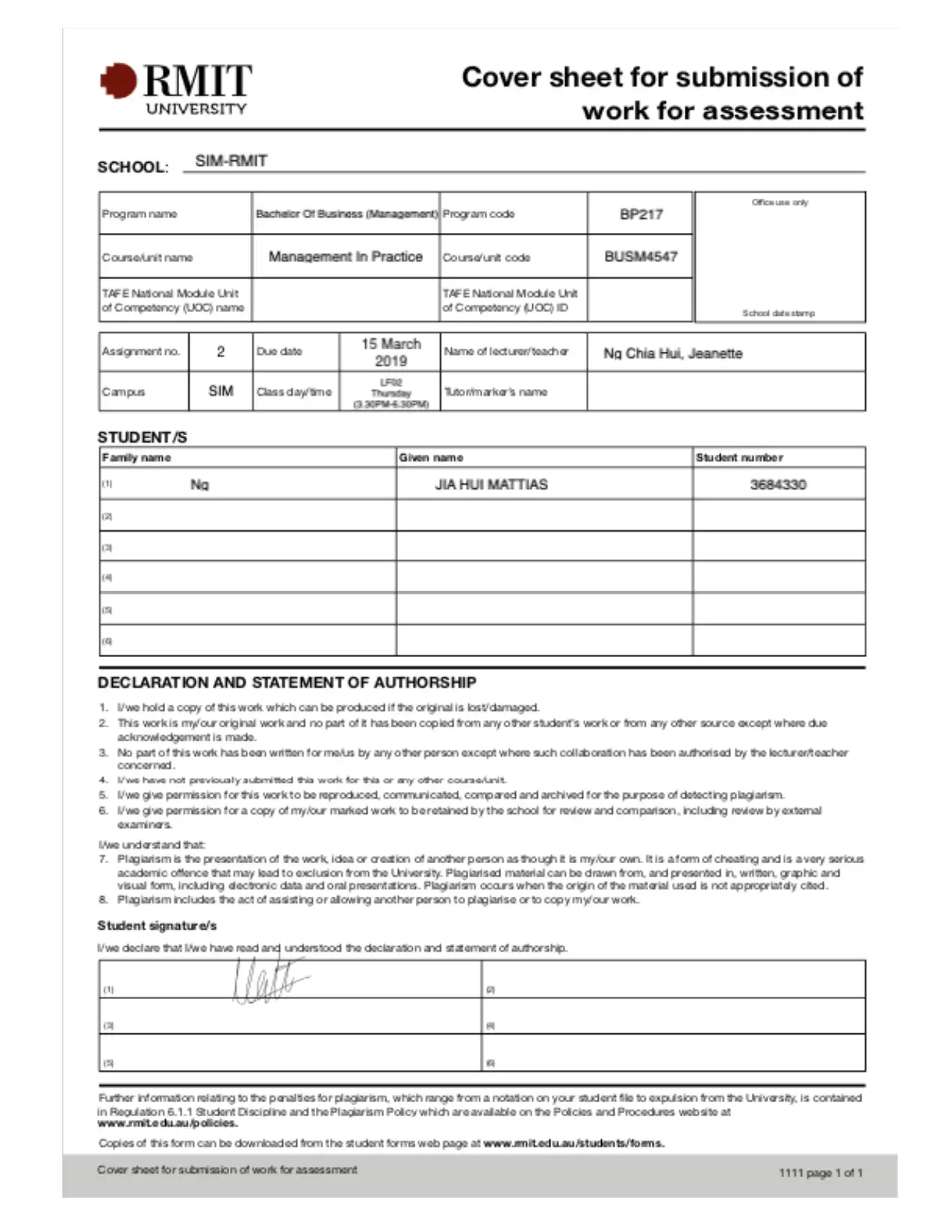
Paraphrase This Document
Need a fresh take? Get an instant paraphrase of this document with our AI Paraphraser
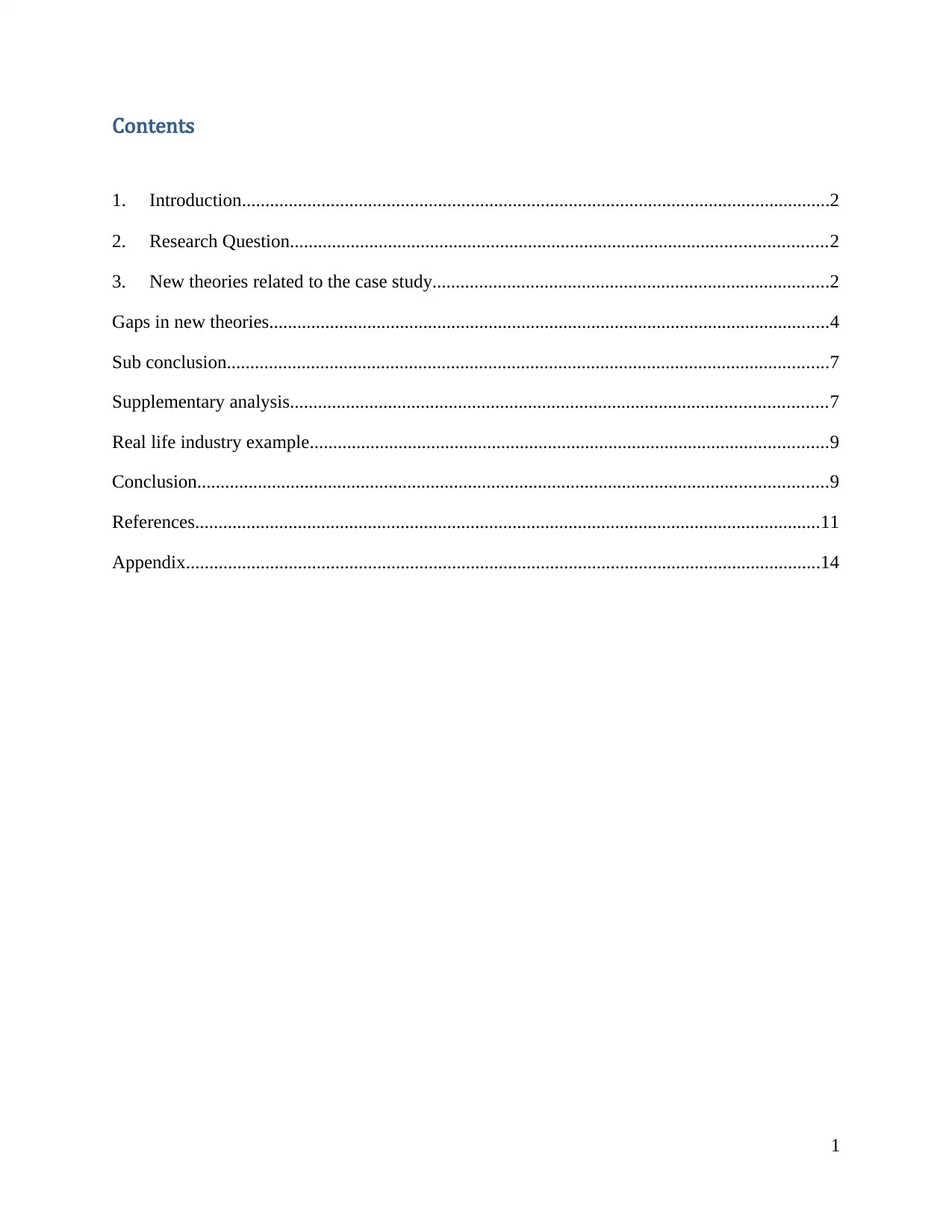
Contents
1. Introduction..............................................................................................................................2
2. Research Question...................................................................................................................2
3. New theories related to the case study.....................................................................................2
Gaps in new theories........................................................................................................................4
Sub conclusion.................................................................................................................................7
Supplementary analysis...................................................................................................................7
Real life industry example...............................................................................................................9
Conclusion.......................................................................................................................................9
References......................................................................................................................................11
Appendix........................................................................................................................................14
1
1. Introduction..............................................................................................................................2
2. Research Question...................................................................................................................2
3. New theories related to the case study.....................................................................................2
Gaps in new theories........................................................................................................................4
Sub conclusion.................................................................................................................................7
Supplementary analysis...................................................................................................................7
Real life industry example...............................................................................................................9
Conclusion.......................................................................................................................................9
References......................................................................................................................................11
Appendix........................................................................................................................................14
1
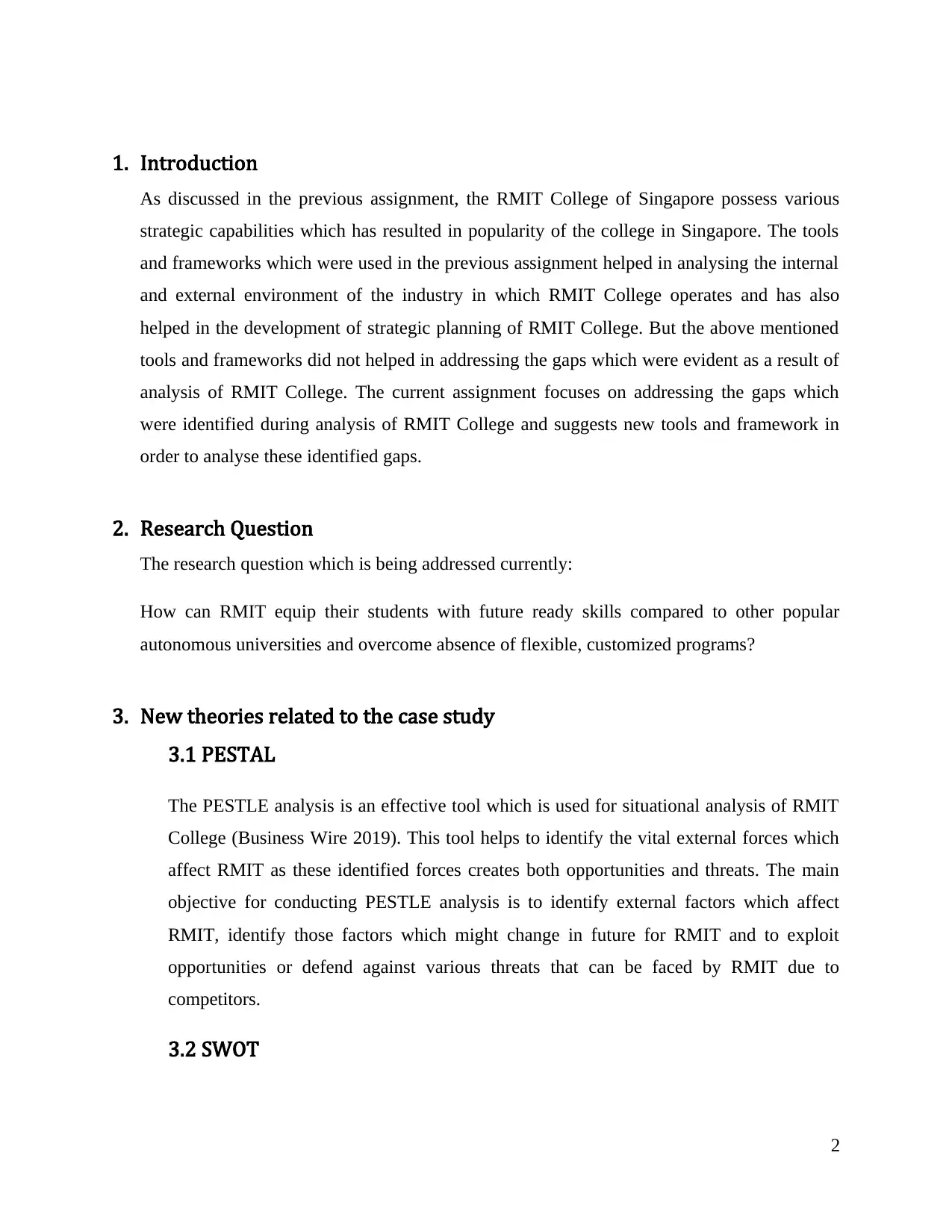
1. Introduction
As discussed in the previous assignment, the RMIT College of Singapore possess various
strategic capabilities which has resulted in popularity of the college in Singapore. The tools
and frameworks which were used in the previous assignment helped in analysing the internal
and external environment of the industry in which RMIT College operates and has also
helped in the development of strategic planning of RMIT College. But the above mentioned
tools and frameworks did not helped in addressing the gaps which were evident as a result of
analysis of RMIT College. The current assignment focuses on addressing the gaps which
were identified during analysis of RMIT College and suggests new tools and framework in
order to analyse these identified gaps.
2. Research Question
The research question which is being addressed currently:
How can RMIT equip their students with future ready skills compared to other popular
autonomous universities and overcome absence of flexible, customized programs?
3. New theories related to the case study
3.1 PESTAL
The PESTLE analysis is an effective tool which is used for situational analysis of RMIT
College (Business Wire 2019). This tool helps to identify the vital external forces which
affect RMIT as these identified forces creates both opportunities and threats. The main
objective for conducting PESTLE analysis is to identify external factors which affect
RMIT, identify those factors which might change in future for RMIT and to exploit
opportunities or defend against various threats that can be faced by RMIT due to
competitors.
3.2 SWOT
2
As discussed in the previous assignment, the RMIT College of Singapore possess various
strategic capabilities which has resulted in popularity of the college in Singapore. The tools
and frameworks which were used in the previous assignment helped in analysing the internal
and external environment of the industry in which RMIT College operates and has also
helped in the development of strategic planning of RMIT College. But the above mentioned
tools and frameworks did not helped in addressing the gaps which were evident as a result of
analysis of RMIT College. The current assignment focuses on addressing the gaps which
were identified during analysis of RMIT College and suggests new tools and framework in
order to analyse these identified gaps.
2. Research Question
The research question which is being addressed currently:
How can RMIT equip their students with future ready skills compared to other popular
autonomous universities and overcome absence of flexible, customized programs?
3. New theories related to the case study
3.1 PESTAL
The PESTLE analysis is an effective tool which is used for situational analysis of RMIT
College (Business Wire 2019). This tool helps to identify the vital external forces which
affect RMIT as these identified forces creates both opportunities and threats. The main
objective for conducting PESTLE analysis is to identify external factors which affect
RMIT, identify those factors which might change in future for RMIT and to exploit
opportunities or defend against various threats that can be faced by RMIT due to
competitors.
3.2 SWOT
2
⊘ This is a preview!⊘
Do you want full access?
Subscribe today to unlock all pages.

Trusted by 1+ million students worldwide
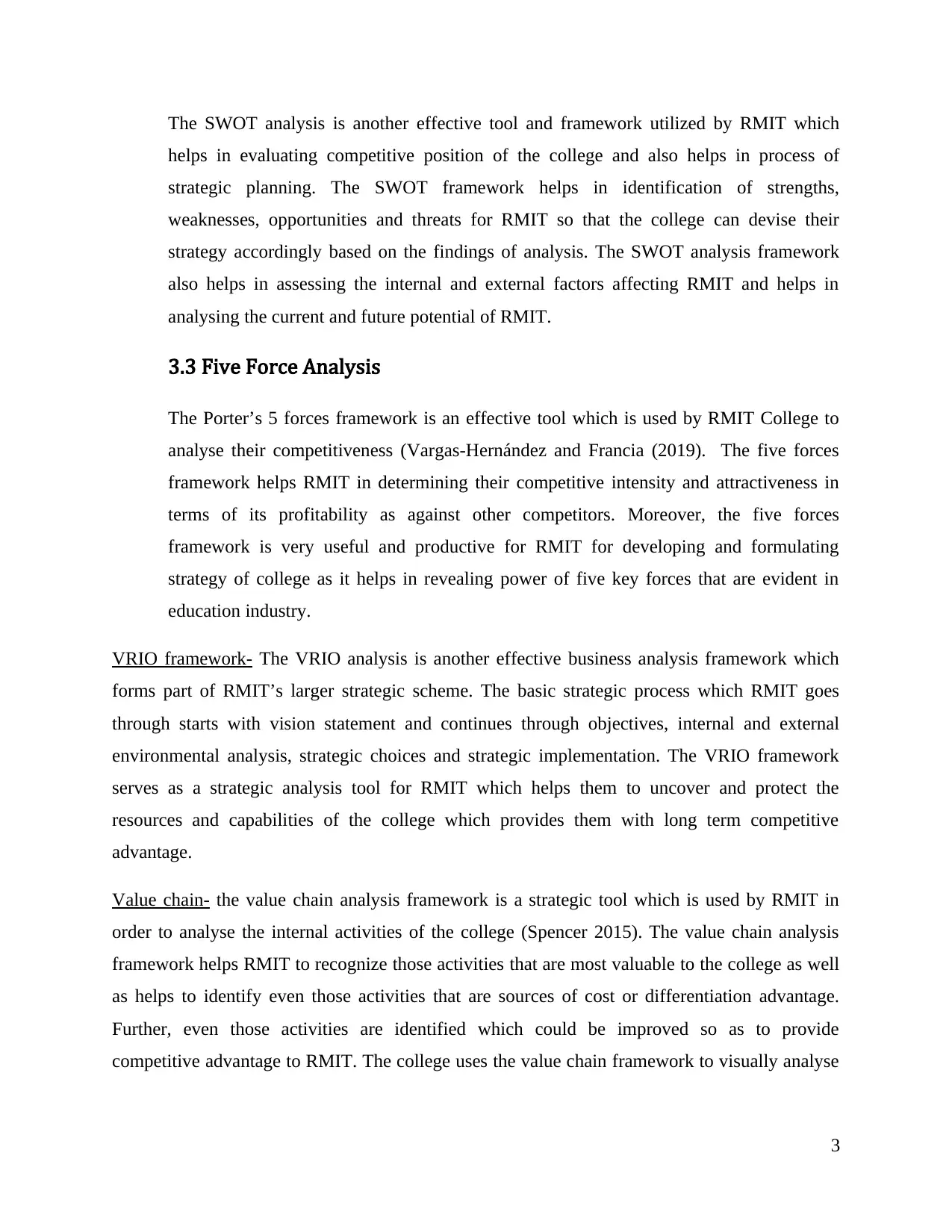
The SWOT analysis is another effective tool and framework utilized by RMIT which
helps in evaluating competitive position of the college and also helps in process of
strategic planning. The SWOT framework helps in identification of strengths,
weaknesses, opportunities and threats for RMIT so that the college can devise their
strategy accordingly based on the findings of analysis. The SWOT analysis framework
also helps in assessing the internal and external factors affecting RMIT and helps in
analysing the current and future potential of RMIT.
3.3 Five Force Analysis
The Porter’s 5 forces framework is an effective tool which is used by RMIT College to
analyse their competitiveness (Vargas-Hernández and Francia (2019). The five forces
framework helps RMIT in determining their competitive intensity and attractiveness in
terms of its profitability as against other competitors. Moreover, the five forces
framework is very useful and productive for RMIT for developing and formulating
strategy of college as it helps in revealing power of five key forces that are evident in
education industry.
VRIO framework- The VRIO analysis is another effective business analysis framework which
forms part of RMIT’s larger strategic scheme. The basic strategic process which RMIT goes
through starts with vision statement and continues through objectives, internal and external
environmental analysis, strategic choices and strategic implementation. The VRIO framework
serves as a strategic analysis tool for RMIT which helps them to uncover and protect the
resources and capabilities of the college which provides them with long term competitive
advantage.
Value chain- the value chain analysis framework is a strategic tool which is used by RMIT in
order to analyse the internal activities of the college (Spencer 2015). The value chain analysis
framework helps RMIT to recognize those activities that are most valuable to the college as well
as helps to identify even those activities that are sources of cost or differentiation advantage.
Further, even those activities are identified which could be improved so as to provide
competitive advantage to RMIT. The college uses the value chain framework to visually analyse
3
helps in evaluating competitive position of the college and also helps in process of
strategic planning. The SWOT framework helps in identification of strengths,
weaknesses, opportunities and threats for RMIT so that the college can devise their
strategy accordingly based on the findings of analysis. The SWOT analysis framework
also helps in assessing the internal and external factors affecting RMIT and helps in
analysing the current and future potential of RMIT.
3.3 Five Force Analysis
The Porter’s 5 forces framework is an effective tool which is used by RMIT College to
analyse their competitiveness (Vargas-Hernández and Francia (2019). The five forces
framework helps RMIT in determining their competitive intensity and attractiveness in
terms of its profitability as against other competitors. Moreover, the five forces
framework is very useful and productive for RMIT for developing and formulating
strategy of college as it helps in revealing power of five key forces that are evident in
education industry.
VRIO framework- The VRIO analysis is another effective business analysis framework which
forms part of RMIT’s larger strategic scheme. The basic strategic process which RMIT goes
through starts with vision statement and continues through objectives, internal and external
environmental analysis, strategic choices and strategic implementation. The VRIO framework
serves as a strategic analysis tool for RMIT which helps them to uncover and protect the
resources and capabilities of the college which provides them with long term competitive
advantage.
Value chain- the value chain analysis framework is a strategic tool which is used by RMIT in
order to analyse the internal activities of the college (Spencer 2015). The value chain analysis
framework helps RMIT to recognize those activities that are most valuable to the college as well
as helps to identify even those activities that are sources of cost or differentiation advantage.
Further, even those activities are identified which could be improved so as to provide
competitive advantage to RMIT. The college uses the value chain framework to visually analyse
3
Paraphrase This Document
Need a fresh take? Get an instant paraphrase of this document with our AI Paraphraser
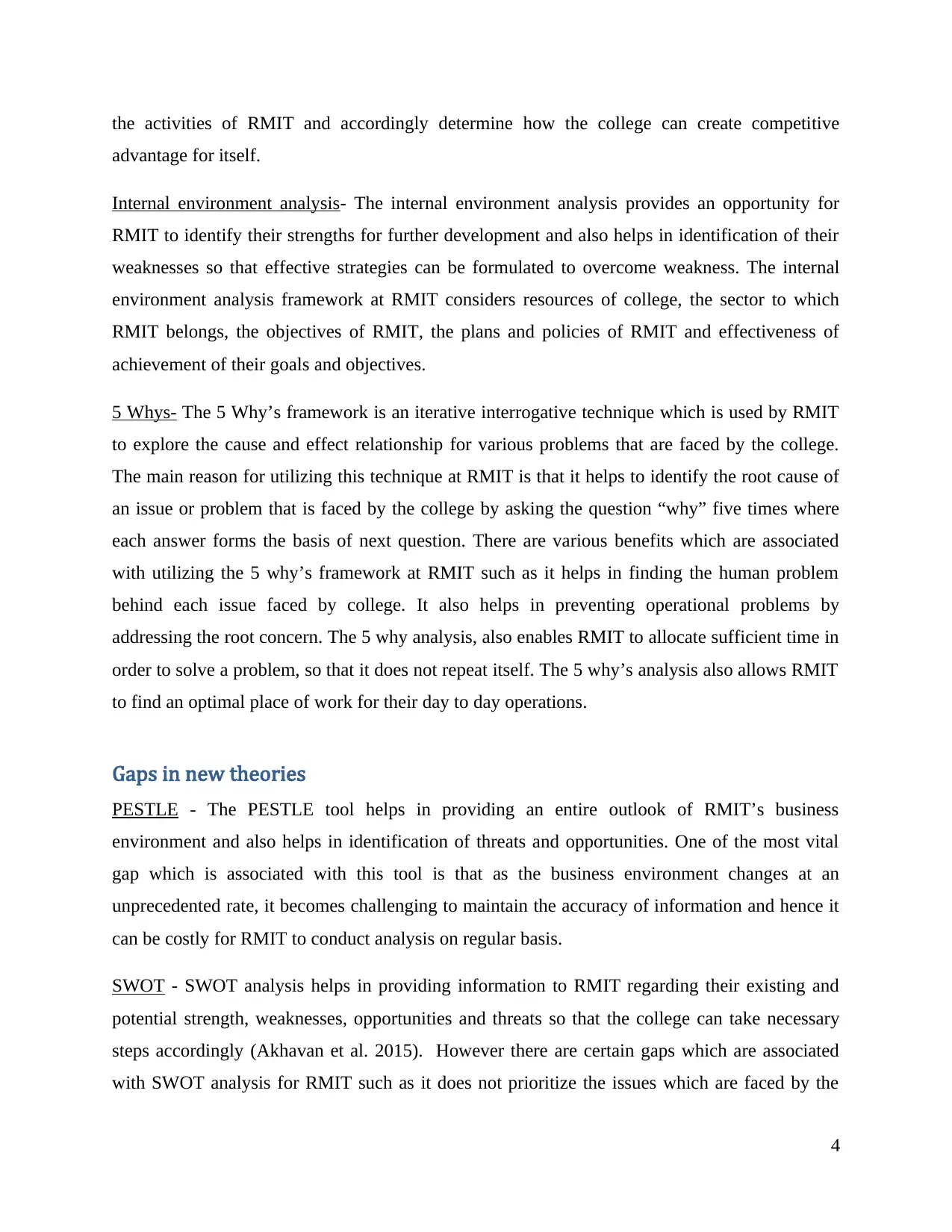
the activities of RMIT and accordingly determine how the college can create competitive
advantage for itself.
Internal environment analysis- The internal environment analysis provides an opportunity for
RMIT to identify their strengths for further development and also helps in identification of their
weaknesses so that effective strategies can be formulated to overcome weakness. The internal
environment analysis framework at RMIT considers resources of college, the sector to which
RMIT belongs, the objectives of RMIT, the plans and policies of RMIT and effectiveness of
achievement of their goals and objectives.
5 Whys- The 5 Why’s framework is an iterative interrogative technique which is used by RMIT
to explore the cause and effect relationship for various problems that are faced by the college.
The main reason for utilizing this technique at RMIT is that it helps to identify the root cause of
an issue or problem that is faced by the college by asking the question “why” five times where
each answer forms the basis of next question. There are various benefits which are associated
with utilizing the 5 why’s framework at RMIT such as it helps in finding the human problem
behind each issue faced by college. It also helps in preventing operational problems by
addressing the root concern. The 5 why analysis, also enables RMIT to allocate sufficient time in
order to solve a problem, so that it does not repeat itself. The 5 why’s analysis also allows RMIT
to find an optimal place of work for their day to day operations.
Gaps in new theories
PESTLE - The PESTLE tool helps in providing an entire outlook of RMIT’s business
environment and also helps in identification of threats and opportunities. One of the most vital
gap which is associated with this tool is that as the business environment changes at an
unprecedented rate, it becomes challenging to maintain the accuracy of information and hence it
can be costly for RMIT to conduct analysis on regular basis.
SWOT - SWOT analysis helps in providing information to RMIT regarding their existing and
potential strength, weaknesses, opportunities and threats so that the college can take necessary
steps accordingly (Akhavan et al. 2015). However there are certain gaps which are associated
with SWOT analysis for RMIT such as it does not prioritize the issues which are faced by the
4
advantage for itself.
Internal environment analysis- The internal environment analysis provides an opportunity for
RMIT to identify their strengths for further development and also helps in identification of their
weaknesses so that effective strategies can be formulated to overcome weakness. The internal
environment analysis framework at RMIT considers resources of college, the sector to which
RMIT belongs, the objectives of RMIT, the plans and policies of RMIT and effectiveness of
achievement of their goals and objectives.
5 Whys- The 5 Why’s framework is an iterative interrogative technique which is used by RMIT
to explore the cause and effect relationship for various problems that are faced by the college.
The main reason for utilizing this technique at RMIT is that it helps to identify the root cause of
an issue or problem that is faced by the college by asking the question “why” five times where
each answer forms the basis of next question. There are various benefits which are associated
with utilizing the 5 why’s framework at RMIT such as it helps in finding the human problem
behind each issue faced by college. It also helps in preventing operational problems by
addressing the root concern. The 5 why analysis, also enables RMIT to allocate sufficient time in
order to solve a problem, so that it does not repeat itself. The 5 why’s analysis also allows RMIT
to find an optimal place of work for their day to day operations.
Gaps in new theories
PESTLE - The PESTLE tool helps in providing an entire outlook of RMIT’s business
environment and also helps in identification of threats and opportunities. One of the most vital
gap which is associated with this tool is that as the business environment changes at an
unprecedented rate, it becomes challenging to maintain the accuracy of information and hence it
can be costly for RMIT to conduct analysis on regular basis.
SWOT - SWOT analysis helps in providing information to RMIT regarding their existing and
potential strength, weaknesses, opportunities and threats so that the college can take necessary
steps accordingly (Akhavan et al. 2015). However there are certain gaps which are associated
with SWOT analysis for RMIT such as it does not prioritize the issues which are faced by the
4
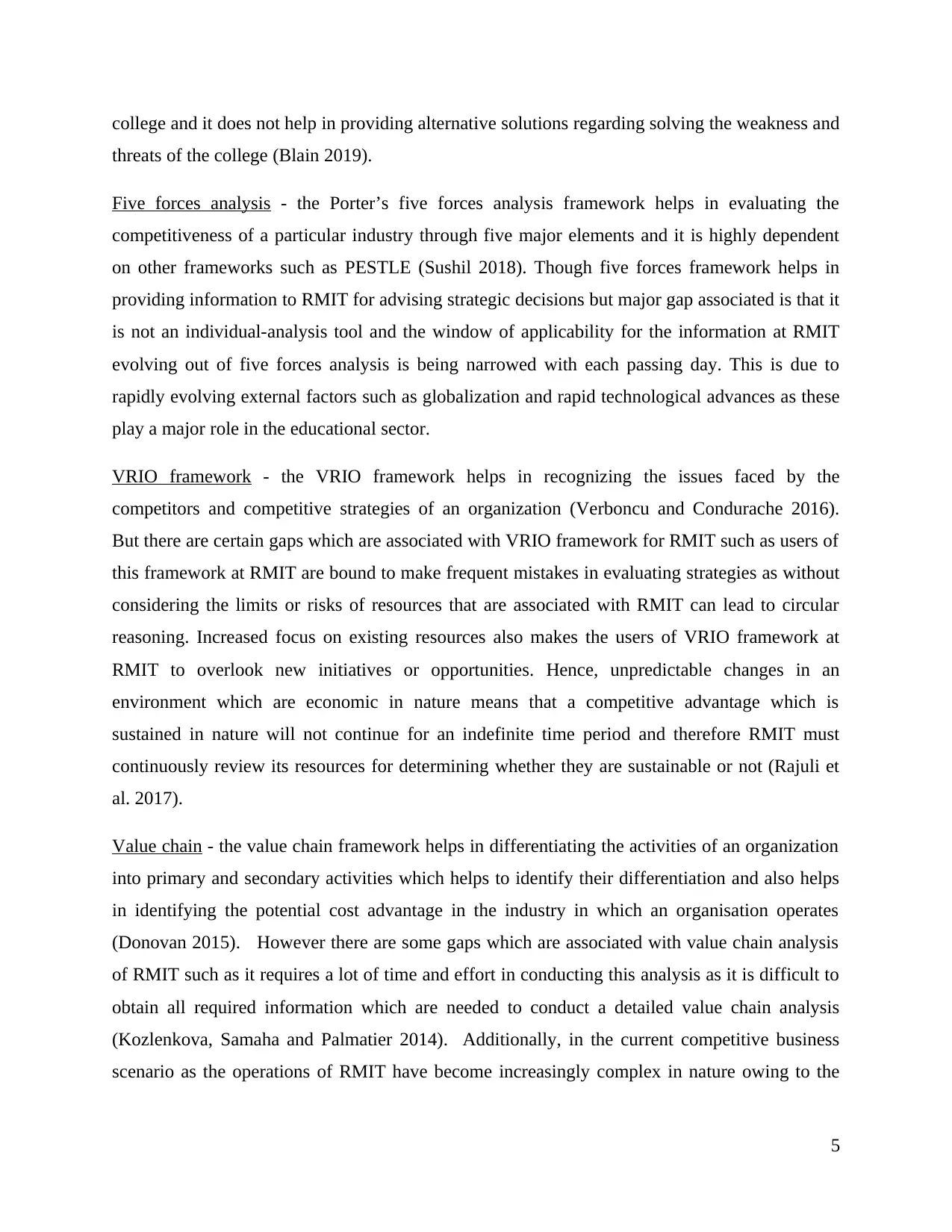
college and it does not help in providing alternative solutions regarding solving the weakness and
threats of the college (Blain 2019).
Five forces analysis - the Porter’s five forces analysis framework helps in evaluating the
competitiveness of a particular industry through five major elements and it is highly dependent
on other frameworks such as PESTLE (Sushil 2018). Though five forces framework helps in
providing information to RMIT for advising strategic decisions but major gap associated is that it
is not an individual-analysis tool and the window of applicability for the information at RMIT
evolving out of five forces analysis is being narrowed with each passing day. This is due to
rapidly evolving external factors such as globalization and rapid technological advances as these
play a major role in the educational sector.
VRIO framework - the VRIO framework helps in recognizing the issues faced by the
competitors and competitive strategies of an organization (Verboncu and Condurache 2016).
But there are certain gaps which are associated with VRIO framework for RMIT such as users of
this framework at RMIT are bound to make frequent mistakes in evaluating strategies as without
considering the limits or risks of resources that are associated with RMIT can lead to circular
reasoning. Increased focus on existing resources also makes the users of VRIO framework at
RMIT to overlook new initiatives or opportunities. Hence, unpredictable changes in an
environment which are economic in nature means that a competitive advantage which is
sustained in nature will not continue for an indefinite time period and therefore RMIT must
continuously review its resources for determining whether they are sustainable or not (Rajuli et
al. 2017).
Value chain - the value chain framework helps in differentiating the activities of an organization
into primary and secondary activities which helps to identify their differentiation and also helps
in identifying the potential cost advantage in the industry in which an organisation operates
(Donovan 2015). However there are some gaps which are associated with value chain analysis
of RMIT such as it requires a lot of time and effort in conducting this analysis as it is difficult to
obtain all required information which are needed to conduct a detailed value chain analysis
(Kozlenkova, Samaha and Palmatier 2014). Additionally, in the current competitive business
scenario as the operations of RMIT have become increasingly complex in nature owing to the
5
threats of the college (Blain 2019).
Five forces analysis - the Porter’s five forces analysis framework helps in evaluating the
competitiveness of a particular industry through five major elements and it is highly dependent
on other frameworks such as PESTLE (Sushil 2018). Though five forces framework helps in
providing information to RMIT for advising strategic decisions but major gap associated is that it
is not an individual-analysis tool and the window of applicability for the information at RMIT
evolving out of five forces analysis is being narrowed with each passing day. This is due to
rapidly evolving external factors such as globalization and rapid technological advances as these
play a major role in the educational sector.
VRIO framework - the VRIO framework helps in recognizing the issues faced by the
competitors and competitive strategies of an organization (Verboncu and Condurache 2016).
But there are certain gaps which are associated with VRIO framework for RMIT such as users of
this framework at RMIT are bound to make frequent mistakes in evaluating strategies as without
considering the limits or risks of resources that are associated with RMIT can lead to circular
reasoning. Increased focus on existing resources also makes the users of VRIO framework at
RMIT to overlook new initiatives or opportunities. Hence, unpredictable changes in an
environment which are economic in nature means that a competitive advantage which is
sustained in nature will not continue for an indefinite time period and therefore RMIT must
continuously review its resources for determining whether they are sustainable or not (Rajuli et
al. 2017).
Value chain - the value chain framework helps in differentiating the activities of an organization
into primary and secondary activities which helps to identify their differentiation and also helps
in identifying the potential cost advantage in the industry in which an organisation operates
(Donovan 2015). However there are some gaps which are associated with value chain analysis
of RMIT such as it requires a lot of time and effort in conducting this analysis as it is difficult to
obtain all required information which are needed to conduct a detailed value chain analysis
(Kozlenkova, Samaha and Palmatier 2014). Additionally, in the current competitive business
scenario as the operations of RMIT have become increasingly complex in nature owing to the
5
⊘ This is a preview!⊘
Do you want full access?
Subscribe today to unlock all pages.

Trusted by 1+ million students worldwide
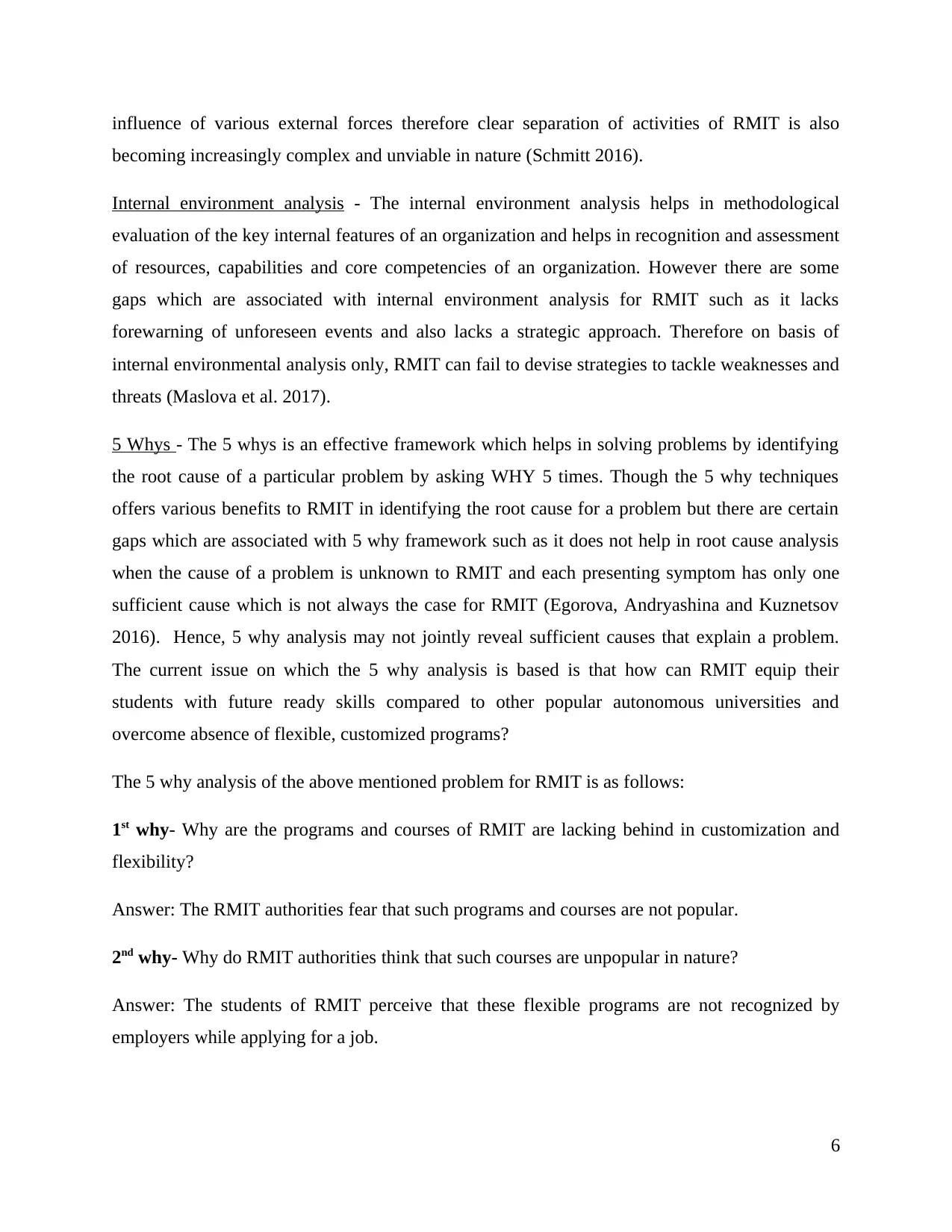
influence of various external forces therefore clear separation of activities of RMIT is also
becoming increasingly complex and unviable in nature (Schmitt 2016).
Internal environment analysis - The internal environment analysis helps in methodological
evaluation of the key internal features of an organization and helps in recognition and assessment
of resources, capabilities and core competencies of an organization. However there are some
gaps which are associated with internal environment analysis for RMIT such as it lacks
forewarning of unforeseen events and also lacks a strategic approach. Therefore on basis of
internal environmental analysis only, RMIT can fail to devise strategies to tackle weaknesses and
threats (Maslova et al. 2017).
5 Whys - The 5 whys is an effective framework which helps in solving problems by identifying
the root cause of a particular problem by asking WHY 5 times. Though the 5 why techniques
offers various benefits to RMIT in identifying the root cause for a problem but there are certain
gaps which are associated with 5 why framework such as it does not help in root cause analysis
when the cause of a problem is unknown to RMIT and each presenting symptom has only one
sufficient cause which is not always the case for RMIT (Egorova, Andryashina and Kuznetsov
2016). Hence, 5 why analysis may not jointly reveal sufficient causes that explain a problem.
The current issue on which the 5 why analysis is based is that how can RMIT equip their
students with future ready skills compared to other popular autonomous universities and
overcome absence of flexible, customized programs?
The 5 why analysis of the above mentioned problem for RMIT is as follows:
1st why- Why are the programs and courses of RMIT are lacking behind in customization and
flexibility?
Answer: The RMIT authorities fear that such programs and courses are not popular.
2nd why- Why do RMIT authorities think that such courses are unpopular in nature?
Answer: The students of RMIT perceive that these flexible programs are not recognized by
employers while applying for a job.
6
becoming increasingly complex and unviable in nature (Schmitt 2016).
Internal environment analysis - The internal environment analysis helps in methodological
evaluation of the key internal features of an organization and helps in recognition and assessment
of resources, capabilities and core competencies of an organization. However there are some
gaps which are associated with internal environment analysis for RMIT such as it lacks
forewarning of unforeseen events and also lacks a strategic approach. Therefore on basis of
internal environmental analysis only, RMIT can fail to devise strategies to tackle weaknesses and
threats (Maslova et al. 2017).
5 Whys - The 5 whys is an effective framework which helps in solving problems by identifying
the root cause of a particular problem by asking WHY 5 times. Though the 5 why techniques
offers various benefits to RMIT in identifying the root cause for a problem but there are certain
gaps which are associated with 5 why framework such as it does not help in root cause analysis
when the cause of a problem is unknown to RMIT and each presenting symptom has only one
sufficient cause which is not always the case for RMIT (Egorova, Andryashina and Kuznetsov
2016). Hence, 5 why analysis may not jointly reveal sufficient causes that explain a problem.
The current issue on which the 5 why analysis is based is that how can RMIT equip their
students with future ready skills compared to other popular autonomous universities and
overcome absence of flexible, customized programs?
The 5 why analysis of the above mentioned problem for RMIT is as follows:
1st why- Why are the programs and courses of RMIT are lacking behind in customization and
flexibility?
Answer: The RMIT authorities fear that such programs and courses are not popular.
2nd why- Why do RMIT authorities think that such courses are unpopular in nature?
Answer: The students of RMIT perceive that these flexible programs are not recognized by
employers while applying for a job.
6
Paraphrase This Document
Need a fresh take? Get an instant paraphrase of this document with our AI Paraphraser
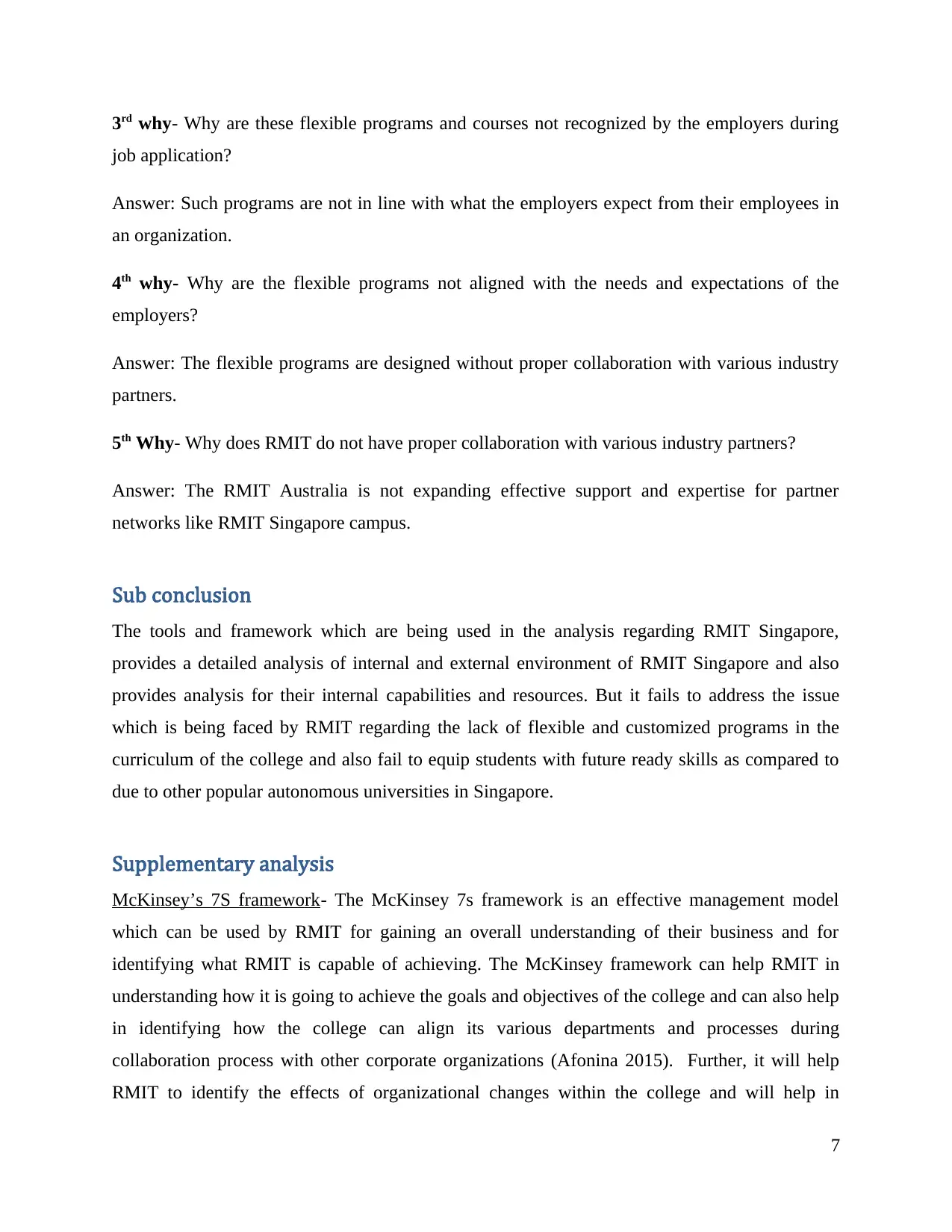
3rd why- Why are these flexible programs and courses not recognized by the employers during
job application?
Answer: Such programs are not in line with what the employers expect from their employees in
an organization.
4th why- Why are the flexible programs not aligned with the needs and expectations of the
employers?
Answer: The flexible programs are designed without proper collaboration with various industry
partners.
5th Why- Why does RMIT do not have proper collaboration with various industry partners?
Answer: The RMIT Australia is not expanding effective support and expertise for partner
networks like RMIT Singapore campus.
Sub conclusion
The tools and framework which are being used in the analysis regarding RMIT Singapore,
provides a detailed analysis of internal and external environment of RMIT Singapore and also
provides analysis for their internal capabilities and resources. But it fails to address the issue
which is being faced by RMIT regarding the lack of flexible and customized programs in the
curriculum of the college and also fail to equip students with future ready skills as compared to
due to other popular autonomous universities in Singapore.
Supplementary analysis
McKinsey’s 7S framework- The McKinsey 7s framework is an effective management model
which can be used by RMIT for gaining an overall understanding of their business and for
identifying what RMIT is capable of achieving. The McKinsey framework can help RMIT in
understanding how it is going to achieve the goals and objectives of the college and can also help
in identifying how the college can align its various departments and processes during
collaboration process with other corporate organizations (Afonina 2015). Further, it will help
RMIT to identify the effects of organizational changes within the college and will help in
7
job application?
Answer: Such programs are not in line with what the employers expect from their employees in
an organization.
4th why- Why are the flexible programs not aligned with the needs and expectations of the
employers?
Answer: The flexible programs are designed without proper collaboration with various industry
partners.
5th Why- Why does RMIT do not have proper collaboration with various industry partners?
Answer: The RMIT Australia is not expanding effective support and expertise for partner
networks like RMIT Singapore campus.
Sub conclusion
The tools and framework which are being used in the analysis regarding RMIT Singapore,
provides a detailed analysis of internal and external environment of RMIT Singapore and also
provides analysis for their internal capabilities and resources. But it fails to address the issue
which is being faced by RMIT regarding the lack of flexible and customized programs in the
curriculum of the college and also fail to equip students with future ready skills as compared to
due to other popular autonomous universities in Singapore.
Supplementary analysis
McKinsey’s 7S framework- The McKinsey 7s framework is an effective management model
which can be used by RMIT for gaining an overall understanding of their business and for
identifying what RMIT is capable of achieving. The McKinsey framework can help RMIT in
understanding how it is going to achieve the goals and objectives of the college and can also help
in identifying how the college can align its various departments and processes during
collaboration process with other corporate organizations (Afonina 2015). Further, it will help
RMIT to identify the effects of organizational changes within the college and will help in
7
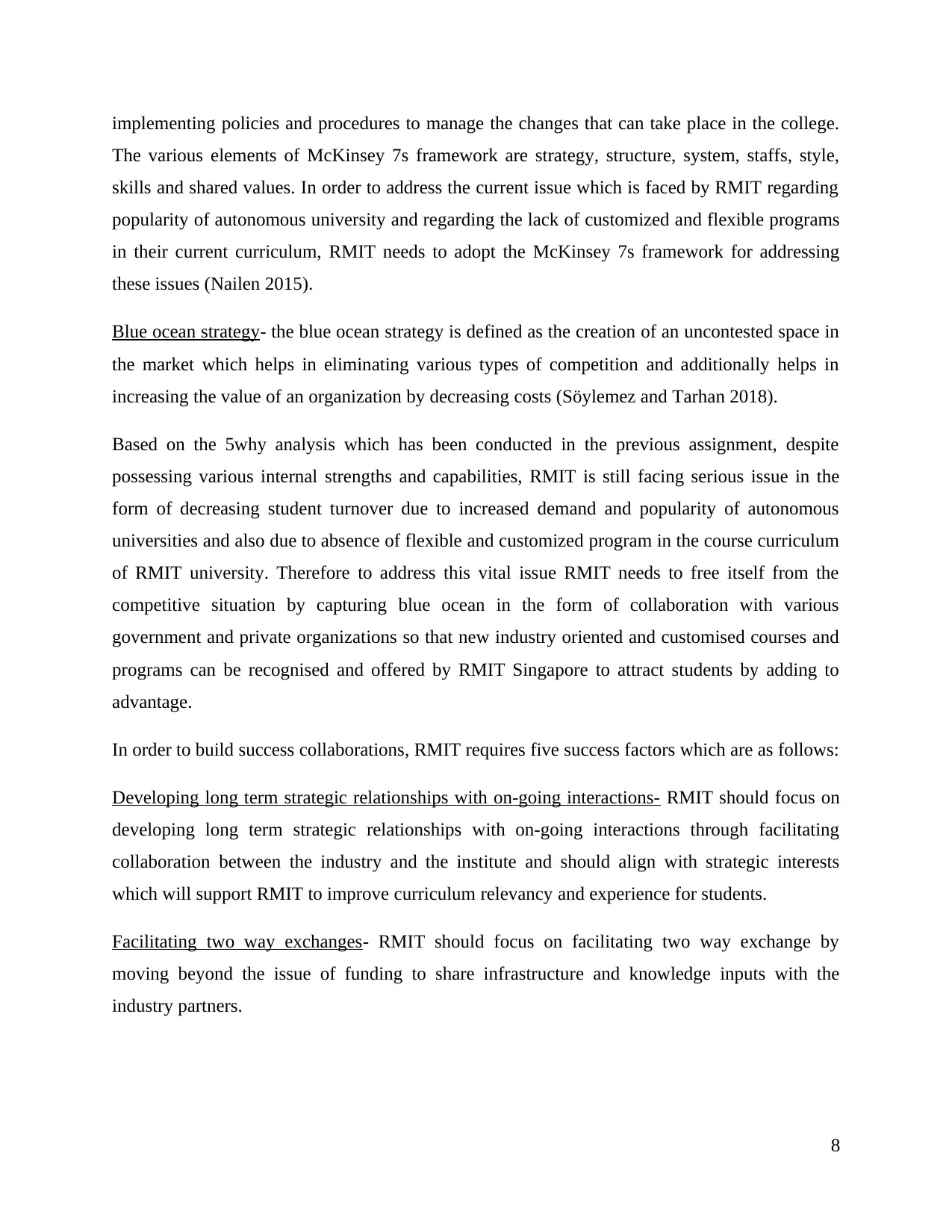
implementing policies and procedures to manage the changes that can take place in the college.
The various elements of McKinsey 7s framework are strategy, structure, system, staffs, style,
skills and shared values. In order to address the current issue which is faced by RMIT regarding
popularity of autonomous university and regarding the lack of customized and flexible programs
in their current curriculum, RMIT needs to adopt the McKinsey 7s framework for addressing
these issues (Nailen 2015).
Blue ocean strategy- the blue ocean strategy is defined as the creation of an uncontested space in
the market which helps in eliminating various types of competition and additionally helps in
increasing the value of an organization by decreasing costs (Söylemez and Tarhan 2018).
Based on the 5why analysis which has been conducted in the previous assignment, despite
possessing various internal strengths and capabilities, RMIT is still facing serious issue in the
form of decreasing student turnover due to increased demand and popularity of autonomous
universities and also due to absence of flexible and customized program in the course curriculum
of RMIT university. Therefore to address this vital issue RMIT needs to free itself from the
competitive situation by capturing blue ocean in the form of collaboration with various
government and private organizations so that new industry oriented and customised courses and
programs can be recognised and offered by RMIT Singapore to attract students by adding to
advantage.
In order to build success collaborations, RMIT requires five success factors which are as follows:
Developing long term strategic relationships with on-going interactions- RMIT should focus on
developing long term strategic relationships with on-going interactions through facilitating
collaboration between the industry and the institute and should align with strategic interests
which will support RMIT to improve curriculum relevancy and experience for students.
Facilitating two way exchanges- RMIT should focus on facilitating two way exchange by
moving beyond the issue of funding to share infrastructure and knowledge inputs with the
industry partners.
8
The various elements of McKinsey 7s framework are strategy, structure, system, staffs, style,
skills and shared values. In order to address the current issue which is faced by RMIT regarding
popularity of autonomous university and regarding the lack of customized and flexible programs
in their current curriculum, RMIT needs to adopt the McKinsey 7s framework for addressing
these issues (Nailen 2015).
Blue ocean strategy- the blue ocean strategy is defined as the creation of an uncontested space in
the market which helps in eliminating various types of competition and additionally helps in
increasing the value of an organization by decreasing costs (Söylemez and Tarhan 2018).
Based on the 5why analysis which has been conducted in the previous assignment, despite
possessing various internal strengths and capabilities, RMIT is still facing serious issue in the
form of decreasing student turnover due to increased demand and popularity of autonomous
universities and also due to absence of flexible and customized program in the course curriculum
of RMIT university. Therefore to address this vital issue RMIT needs to free itself from the
competitive situation by capturing blue ocean in the form of collaboration with various
government and private organizations so that new industry oriented and customised courses and
programs can be recognised and offered by RMIT Singapore to attract students by adding to
advantage.
In order to build success collaborations, RMIT requires five success factors which are as follows:
Developing long term strategic relationships with on-going interactions- RMIT should focus on
developing long term strategic relationships with on-going interactions through facilitating
collaboration between the industry and the institute and should align with strategic interests
which will support RMIT to improve curriculum relevancy and experience for students.
Facilitating two way exchanges- RMIT should focus on facilitating two way exchange by
moving beyond the issue of funding to share infrastructure and knowledge inputs with the
industry partners.
8
⊘ This is a preview!⊘
Do you want full access?
Subscribe today to unlock all pages.

Trusted by 1+ million students worldwide
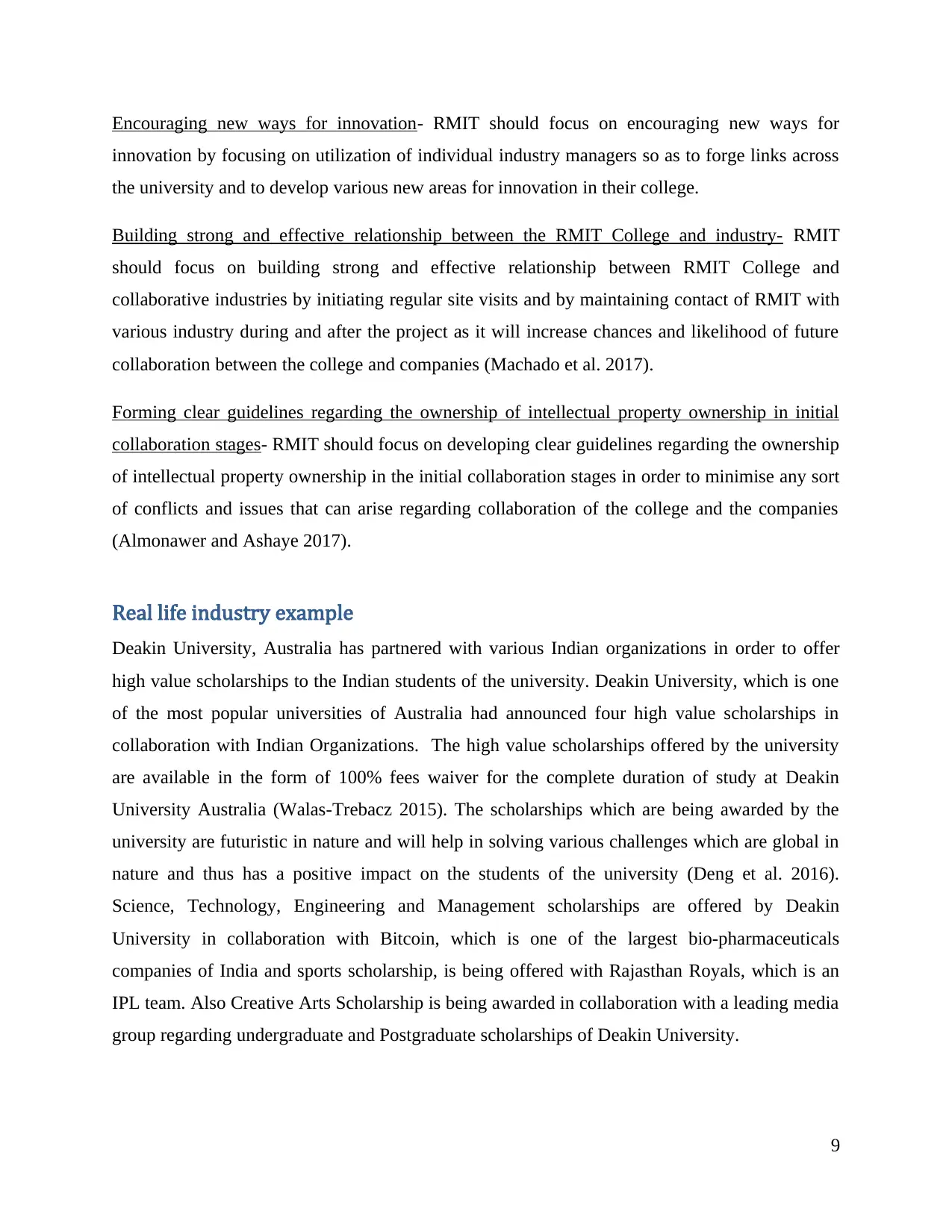
Encouraging new ways for innovation- RMIT should focus on encouraging new ways for
innovation by focusing on utilization of individual industry managers so as to forge links across
the university and to develop various new areas for innovation in their college.
Building strong and effective relationship between the RMIT College and industry- RMIT
should focus on building strong and effective relationship between RMIT College and
collaborative industries by initiating regular site visits and by maintaining contact of RMIT with
various industry during and after the project as it will increase chances and likelihood of future
collaboration between the college and companies (Machado et al. 2017).
Forming clear guidelines regarding the ownership of intellectual property ownership in initial
collaboration stages- RMIT should focus on developing clear guidelines regarding the ownership
of intellectual property ownership in the initial collaboration stages in order to minimise any sort
of conflicts and issues that can arise regarding collaboration of the college and the companies
(Almonawer and Ashaye 2017).
Real life industry example
Deakin University, Australia has partnered with various Indian organizations in order to offer
high value scholarships to the Indian students of the university. Deakin University, which is one
of the most popular universities of Australia had announced four high value scholarships in
collaboration with Indian Organizations. The high value scholarships offered by the university
are available in the form of 100% fees waiver for the complete duration of study at Deakin
University Australia (Walas-Trebacz 2015). The scholarships which are being awarded by the
university are futuristic in nature and will help in solving various challenges which are global in
nature and thus has a positive impact on the students of the university (Deng et al. 2016).
Science, Technology, Engineering and Management scholarships are offered by Deakin
University in collaboration with Bitcoin, which is one of the largest bio-pharmaceuticals
companies of India and sports scholarship, is being offered with Rajasthan Royals, which is an
IPL team. Also Creative Arts Scholarship is being awarded in collaboration with a leading media
group regarding undergraduate and Postgraduate scholarships of Deakin University.
9
innovation by focusing on utilization of individual industry managers so as to forge links across
the university and to develop various new areas for innovation in their college.
Building strong and effective relationship between the RMIT College and industry- RMIT
should focus on building strong and effective relationship between RMIT College and
collaborative industries by initiating regular site visits and by maintaining contact of RMIT with
various industry during and after the project as it will increase chances and likelihood of future
collaboration between the college and companies (Machado et al. 2017).
Forming clear guidelines regarding the ownership of intellectual property ownership in initial
collaboration stages- RMIT should focus on developing clear guidelines regarding the ownership
of intellectual property ownership in the initial collaboration stages in order to minimise any sort
of conflicts and issues that can arise regarding collaboration of the college and the companies
(Almonawer and Ashaye 2017).
Real life industry example
Deakin University, Australia has partnered with various Indian organizations in order to offer
high value scholarships to the Indian students of the university. Deakin University, which is one
of the most popular universities of Australia had announced four high value scholarships in
collaboration with Indian Organizations. The high value scholarships offered by the university
are available in the form of 100% fees waiver for the complete duration of study at Deakin
University Australia (Walas-Trebacz 2015). The scholarships which are being awarded by the
university are futuristic in nature and will help in solving various challenges which are global in
nature and thus has a positive impact on the students of the university (Deng et al. 2016).
Science, Technology, Engineering and Management scholarships are offered by Deakin
University in collaboration with Bitcoin, which is one of the largest bio-pharmaceuticals
companies of India and sports scholarship, is being offered with Rajasthan Royals, which is an
IPL team. Also Creative Arts Scholarship is being awarded in collaboration with a leading media
group regarding undergraduate and Postgraduate scholarships of Deakin University.
9
Paraphrase This Document
Need a fresh take? Get an instant paraphrase of this document with our AI Paraphraser
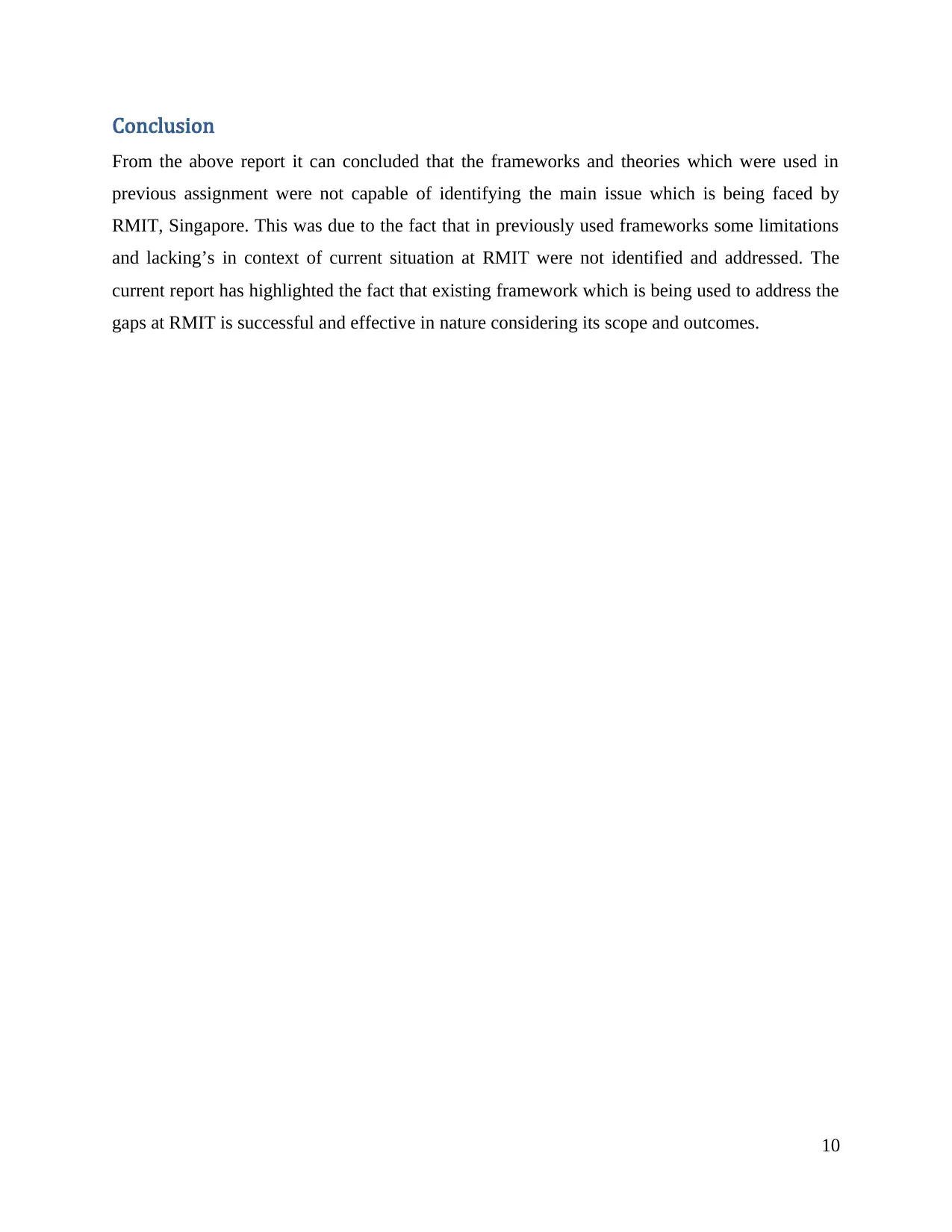
Conclusion
From the above report it can concluded that the frameworks and theories which were used in
previous assignment were not capable of identifying the main issue which is being faced by
RMIT, Singapore. This was due to the fact that in previously used frameworks some limitations
and lacking’s in context of current situation at RMIT were not identified and addressed. The
current report has highlighted the fact that existing framework which is being used to address the
gaps at RMIT is successful and effective in nature considering its scope and outcomes.
10
From the above report it can concluded that the frameworks and theories which were used in
previous assignment were not capable of identifying the main issue which is being faced by
RMIT, Singapore. This was due to the fact that in previously used frameworks some limitations
and lacking’s in context of current situation at RMIT were not identified and addressed. The
current report has highlighted the fact that existing framework which is being used to address the
gaps at RMIT is successful and effective in nature considering its scope and outcomes.
10
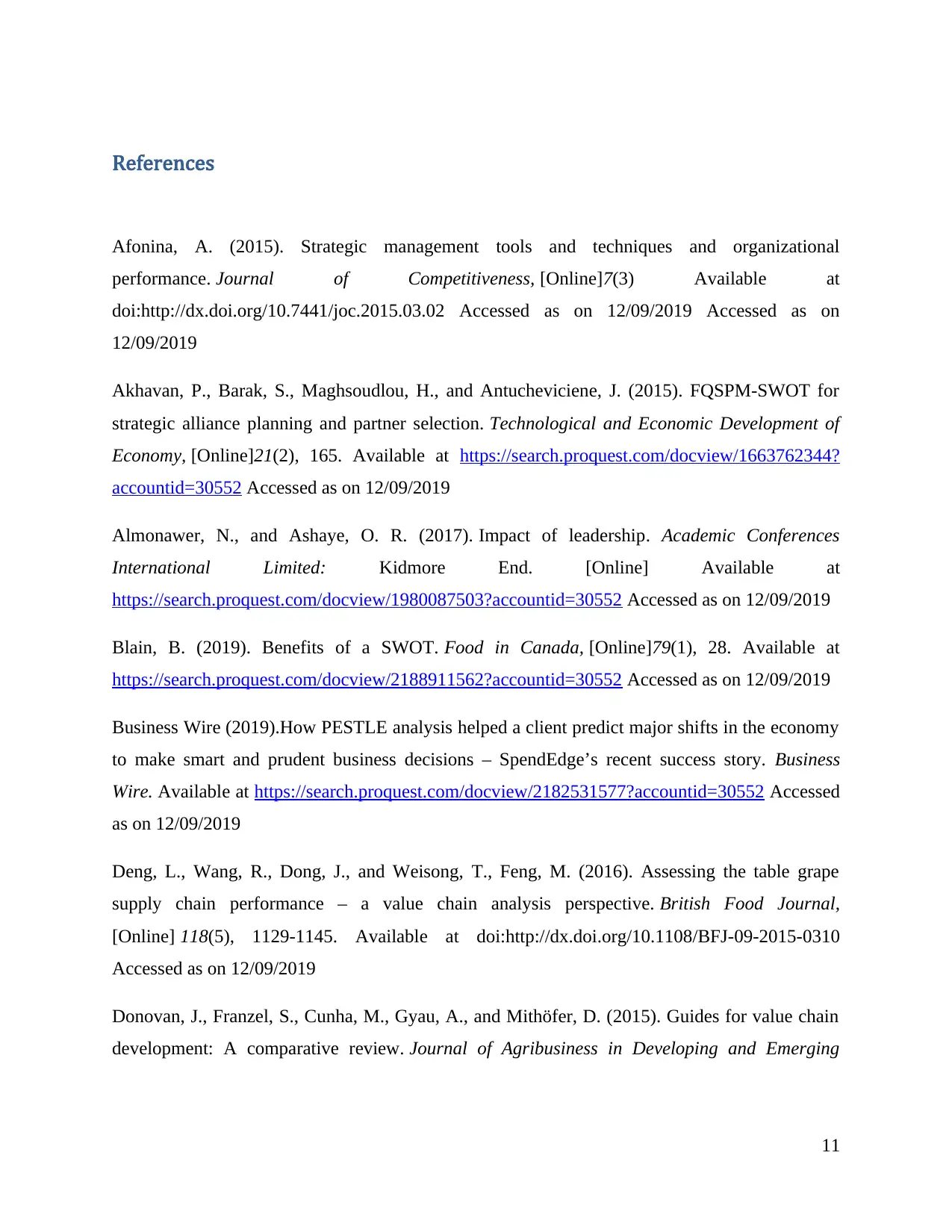
References
Afonina, A. (2015). Strategic management tools and techniques and organizational
performance. Journal of Competitiveness, [Online]7(3) Available at
doi:http://dx.doi.org/10.7441/joc.2015.03.02 Accessed as on 12/09/2019 Accessed as on
12/09/2019
Akhavan, P., Barak, S., Maghsoudlou, H., and Antucheviciene, J. (2015). FQSPM-SWOT for
strategic alliance planning and partner selection. Technological and Economic Development of
Economy, [Online]21(2), 165. Available at https://search.proquest.com/docview/1663762344?
accountid=30552 Accessed as on 12/09/2019
Almonawer, N., and Ashaye, O. R. (2017). Impact of leadership. Academic Conferences
International Limited: Kidmore End. [Online] Available at
https://search.proquest.com/docview/1980087503?accountid=30552 Accessed as on 12/09/2019
Blain, B. (2019). Benefits of a SWOT. Food in Canada, [Online]79(1), 28. Available at
https://search.proquest.com/docview/2188911562?accountid=30552 Accessed as on 12/09/2019
Business Wire (2019).How PESTLE analysis helped a client predict major shifts in the economy
to make smart and prudent business decisions – SpendEdge’s recent success story. Business
Wire. Available at https://search.proquest.com/docview/2182531577?accountid=30552 Accessed
as on 12/09/2019
Deng, L., Wang, R., Dong, J., and Weisong, T., Feng, M. (2016). Assessing the table grape
supply chain performance – a value chain analysis perspective. British Food Journal,
[Online] 118(5), 1129-1145. Available at doi:http://dx.doi.org/10.1108/BFJ-09-2015-0310
Accessed as on 12/09/2019
Donovan, J., Franzel, S., Cunha, M., Gyau, A., and Mithöfer, D. (2015). Guides for value chain
development: A comparative review. Journal of Agribusiness in Developing and Emerging
11
Afonina, A. (2015). Strategic management tools and techniques and organizational
performance. Journal of Competitiveness, [Online]7(3) Available at
doi:http://dx.doi.org/10.7441/joc.2015.03.02 Accessed as on 12/09/2019 Accessed as on
12/09/2019
Akhavan, P., Barak, S., Maghsoudlou, H., and Antucheviciene, J. (2015). FQSPM-SWOT for
strategic alliance planning and partner selection. Technological and Economic Development of
Economy, [Online]21(2), 165. Available at https://search.proquest.com/docview/1663762344?
accountid=30552 Accessed as on 12/09/2019
Almonawer, N., and Ashaye, O. R. (2017). Impact of leadership. Academic Conferences
International Limited: Kidmore End. [Online] Available at
https://search.proquest.com/docview/1980087503?accountid=30552 Accessed as on 12/09/2019
Blain, B. (2019). Benefits of a SWOT. Food in Canada, [Online]79(1), 28. Available at
https://search.proquest.com/docview/2188911562?accountid=30552 Accessed as on 12/09/2019
Business Wire (2019).How PESTLE analysis helped a client predict major shifts in the economy
to make smart and prudent business decisions – SpendEdge’s recent success story. Business
Wire. Available at https://search.proquest.com/docview/2182531577?accountid=30552 Accessed
as on 12/09/2019
Deng, L., Wang, R., Dong, J., and Weisong, T., Feng, M. (2016). Assessing the table grape
supply chain performance – a value chain analysis perspective. British Food Journal,
[Online] 118(5), 1129-1145. Available at doi:http://dx.doi.org/10.1108/BFJ-09-2015-0310
Accessed as on 12/09/2019
Donovan, J., Franzel, S., Cunha, M., Gyau, A., and Mithöfer, D. (2015). Guides for value chain
development: A comparative review. Journal of Agribusiness in Developing and Emerging
11
⊘ This is a preview!⊘
Do you want full access?
Subscribe today to unlock all pages.

Trusted by 1+ million students worldwide
1 out of 16
Related Documents
Your All-in-One AI-Powered Toolkit for Academic Success.
+13062052269
info@desklib.com
Available 24*7 on WhatsApp / Email
![[object Object]](/_next/static/media/star-bottom.7253800d.svg)
Unlock your academic potential
Copyright © 2020–2025 A2Z Services. All Rights Reserved. Developed and managed by ZUCOL.




